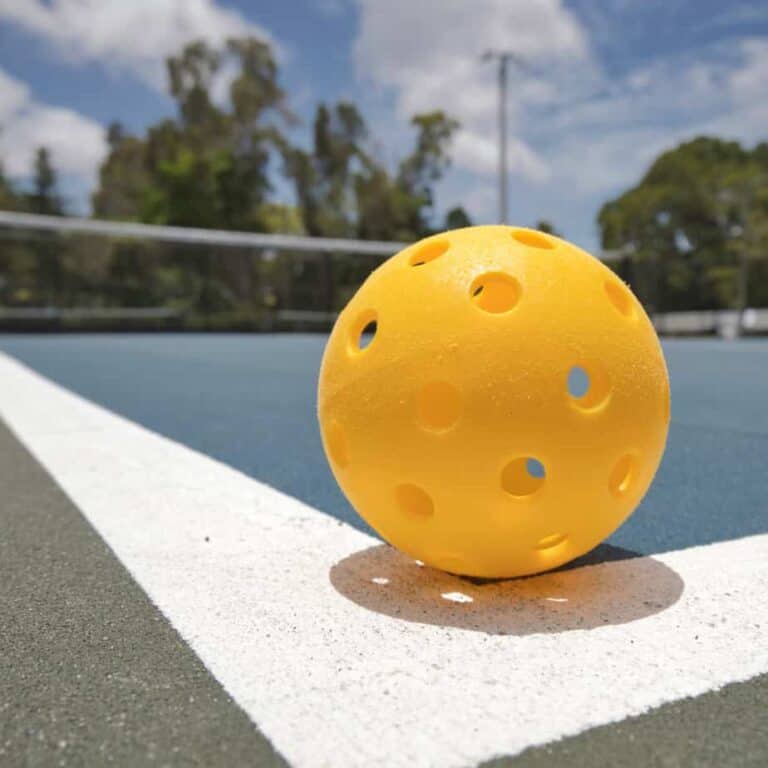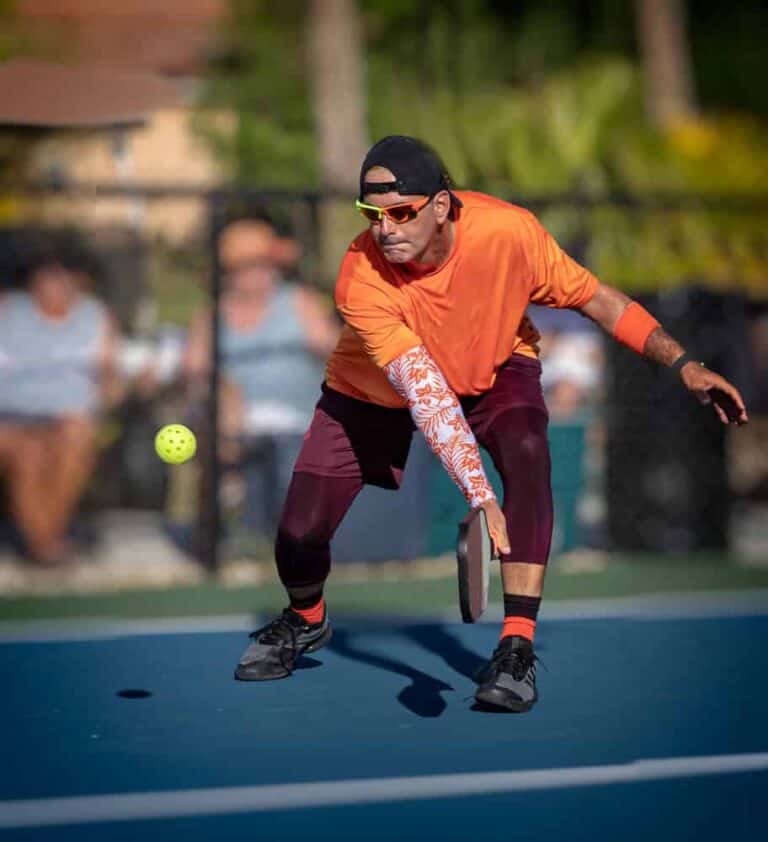How To Serve In Pickleball For Beginners
A consistent serve is one of the most important skills a beginner should learn in the game of pickleball. But if you’re a completely new player, or perhaps even transitioning from another racquet sport, you’ll find that it can be a lot harder than it looks. So, this is how to serve in pickleball for beginners.
The best way to serve in pickleball, especially for beginners, is to grip the paddle like a frying pan, swing nice and easy underhanded below the waistline and aim for the foot of your opponent’s non-dominant side. For example, the left foot of a right-handed player.
Where To Stand When Serving In Pickleball
For a serve to be legal in pickleball, you must stand at the back of the court between the centerlines and behind the baseline, which is the white line farthest from the net.
The baseline or the service line is essentially the same thing.
I’ve found the best place to stand is in the middle of the baseline between the centerline and baseline. This gives you a happy medium to aim for your opponent’s non-dominant side.
However, if your opponent is lined up way off to the side or corner to give themselves a great forehand return, I like to line up towards the center line to see if I can sneak a fast serve down the ally or “lane” that they’ve created for me.
Just remember, any legal serve in pickleball must be done with both feet behind the baseline.
Can you step over the baseline while serving in pickleball? The answer is no, both feet must be clearly behind the baseline before the ball is struck.
However, after the ball is struck, your feet may come in contact with the baseline.
For more basic tips on where to stand in pickleball, click here.
How To Stand When Serving In Pickleball
If you’re a beginner in pickleball, it is best to stand with your dominant foot back behind you and your non-dominant foot out in front of you. Leave some room between yourself and the baseline because as you serve, you’ll want to step forward with your non-dominant foot.
For instance, if you’re right-handed, your right foot should be behind you and your left foot out in front. As you swing, you may want to step into the swing with your left hand. This is fine.
In fact, I encourage it!
As you serve, step forward with your non-dominant foot and then follow through with the swing. Rocking your weight from one foot to the other will help give your serve a little extra consistency and power.
To see exactly how this is done, click the link to watch Barrett from PickleballKitchen shift his weight from one foot to the other as he serves.

How To Hold The Paddle When Serving In Pickleball
Pickleball courts are much smaller than tennis courts, so there’s not as much time for a player to change grips between forehand strokes, backhand strokes or dinks at the net.
That’s why many pickleball players use a grip that’s slightly open (meaning the paddle face is open and towards the net, called the Eastern grip, as opposed to the Continental or Western grips we see more in tennis.
First, grip the paddle like a frying pan so that your thumb and index finger make a “v” that points to your chin when you hold it out.
But to serve in pickleball, especially if you’re a beginner, it’s ok to use this grip and open the paddle face even more so that your wrists and paddle face is aiming upward. From there, your paddle face is open and ready to make contact with the ball at the center of the paddle, aka the sweet spot.
Depending on your skill level, you can keep your paddle face flat aiming upward or if you want to add a little topspin or more speed, turn the paddle face inward towards the net.
Play with it a little, and go with what feels the best and gives you the most consistent, deeply placed serve.
Beginner Quick Tip: If you’re a beginner just learning the game of pickleball, prioritize deep placement over power and spin.
How To Swing When Serving In Pickleball
The pickleball serve is an underhanded stroke—kind of like bowling. If you come from a sport that uses an overhand or a sidestroke, you may experience a steeper learning curve when adjusting to this kind of swing.
Underhand serves may look simple, but to make them deep and on-target, they’re actually tougher than you might think.
Here are a few important rules to remember:
- The serve swings underhanded and then has an upward arc.
- The point of contact must be below your navel.
- The paddle face has to be below your waist.
You can drop the ball (not toss it up) and let it bounce and then hit it, as long as you make contact with the ball below your navel and as long as the paddle is aiming below your wrist.
This is where beginners get into trouble sometimes. The serve might be below the navel but their paddle is angled above their wrist line. Or even parallel to it. This is awfully close to a forehand shot and is not a legal serve in pickleball.
Fun Fact: No matter how high you drop a pickleball from, it will never bounce richer than its supposed to. That is why a drop serve is now legal.
Related: For more on the basic rules of a pickleball serve, click here.

Where To Aim Your Pickleball Serve If You’re A Beginner
When playing pickleball, your serve must land within the service area that’s diagonally across from you but more importantly, beyond the no-volley zone line.
You can hit the ball either in the forehand corner (near the centerline), the backhand corner (near the sideline), or even right at your opponent. It just needs to bounce inside of the correct service area.
Depending on where your opponent is lined up, any one of these locations is a good option.
But if you’re a beginner, I’ve found that the best serving strategy is to aim for your opponent’s non-dominant foot. So, if you’re serving to a right-handed player, aim for their left foot if they’re standing on the baseline.
If your opponent is standing behind the baseline, aim for the part of the baseline in front of their foot.
Aiming for the feet of your opponent is a good tactic to get them to back up or stay back by the baseline, which gives you more time to get to the net. With that in mind, let’s talk strategy.
Pickleball Serving Strategies For Beginners
In pickleball, whoever controls the net controls the pace of the game, so when it’s your turn to serve, use it to your advantage. Get your opponents as far from the net and the kitchen as possible, and then do your best to keep them there.
The #1 serving strategy in pickleball is to serve it deep! The deeper you serve the ball, the more difficult it is for your opponent to get to the net.
Remember, the return team will most likely get to the net first because of the two-bounce rule, but a good, deep serve can make it harder for your opponents to get to the net easily.
To take it another step further, hitting a deep serve to your opponent’s weak side so it forces a backhand return is a great serving strategy any beginner can try. It’s a more advanced strategy that doesn’t require an immense amount of skill.
Backhand returns are just inherently more difficult to return for most players. So force your opponent into a harder shot whenever possible,
The more effective pickleball serve, regardless of skill level is one that is hit deep to the baseline and forces your opponent to have to hit a backhand return of serve.
Hitting a serve short may seem like an easy way to catch your opponent off guard, but it actually gives them an easier path to the kitchen line.
On that note, your serve also can’t land in the kitchen, including the lined border. That’ll result in a fault for you or your team, which means that you lose the serve.

Serve it up!
Types Of Pickleball Serves
Another element to the strategy of pickleball involves using a variety of serves. Once you’ve gotten the basic beginner’s serve down, where you’re hitting it consistently deep, it can be fun to keep your opponent guessing by adding some other serves to your arsenal. Here are some of the options:
- The Power Serve – The power serve is one where the arc to the ball over the net is low but fast. This serve may not land as deep because the apex of the ball is closer to the net but when done right with speed on the ball, to your opponent’s backhand, it can result in soft pop-up return for you to attack, resulting in an easier third shot drop.
- The Topspin Serve – When you’re ready to add some spin, the topspin serve is a great one to try. This is where you bring your paddle from an open paddle face to a closed paddle face as you’re swinging through and making contact with the ball. It is a low-to-high to low motion so that your paddle comes up and over the ball then down again to create topspin.
- The Backhand Cut Serve – This is a more advanced serve but if you’ve got a good backhand shot to begin with, you may want to try it. Start by drop serving the ball so that it bounces up at you. From here, position yourself for a backhand shot but add some side spin (cutting action) from left to right so that the ball will want to land and then jet out to the left or right on your opponent’s side.
How To Serve In Pickleball For Beginners – Final Thoughts
Serving is a crucial skill in pickleball. Practicing good techniques will get you more wins and make the game more fun.
Stay optimistic, and if you need help figuring it out, don’t be afraid to ask a friend. That’s the beauty of a sport like pickleball – more than anything, it’s a community and a social game. With some practice, you’ll be serving like the best of them in no time at all.

Welcome to TheVolleyLlama.com. My name is Keith, I’m just a lover of all sports that involve a racquet, net and a ball. I played competitive high school varsity tennis, love racquetball and my whole family plays pickleball regularly. I started this website to help give people like you the basics to learn these wonderful games.


